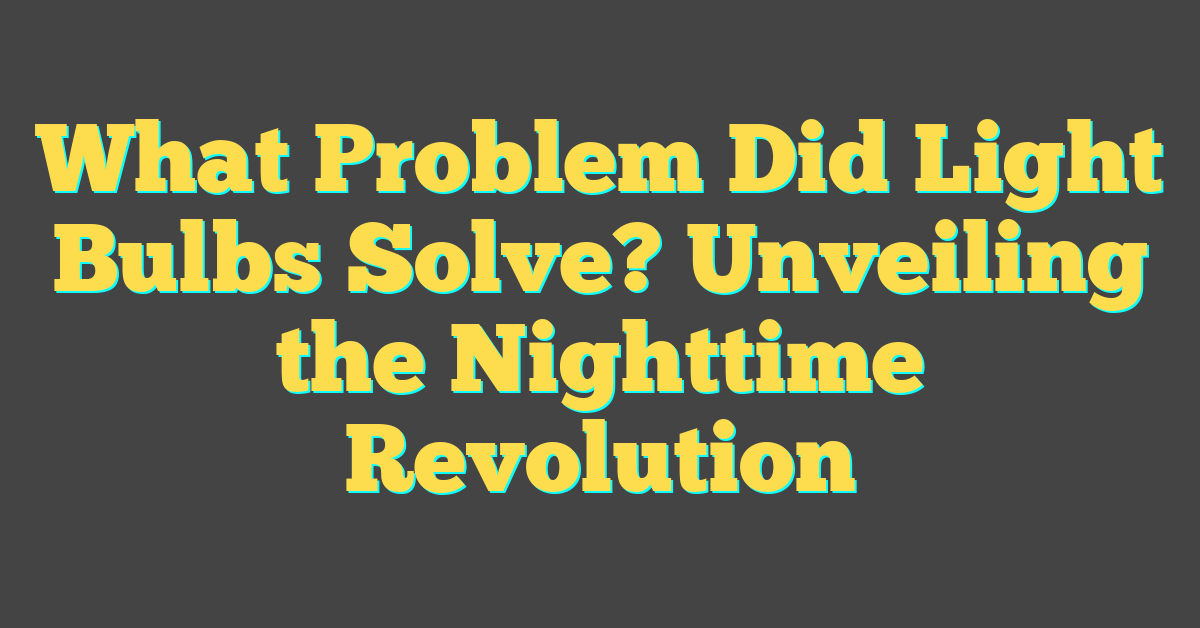Imagine life without the flip of a switch to instantly brighten your room. Before the light bulb’s inception, you’d be relying on candles or oil lamps after sunset, which were not only dim but also a fire hazard. The invention of the light bulb brought about a revolution, transforming night into day at your command.

This marvel of ingenuity solved the age-old problem of extending productive hours into the evening. No longer were you bound by the constraints of daylight, and the risk of fires drastically decreased. The light bulb didn’t just illuminate homes; it sparked an era of unprecedented growth and change across the globe.
The Problem of Dim Lighting at Night
Imagine trying to read, cook, or do intricate tasks with only the flickering light of candles or oil lamps. Not only was it insufficient but it also cast shadows that could play tricks on your eyes. Before the advent of the light bulb, nighttime activities were limited. The dim lighting available was not conducive to productivity or safety.
Candles and oil lamps provided a meager glow, and the risk of eye strain was high. You might’ve found yourself squinting and struggling to concentrate, which could lead to headaches and fatigue. The quality of light directly impacted the quality of work, and a dimly lit environment simply wasn’t where masterpieces were crafted or great ideas were born.
In the workspace, dim lighting wasn’t just inconvenient; it was a deterrent to progress. With the sun’s setting, so dwindled the workday, as artificial light sources failed to provide adequate illumination. Evenings meant slowing down of activities, impacting industries and home businesses alike. In the domestic sphere, you’d be familiar with how crucial good lighting is for tasks like sewing or carpentry, which were frequently done from home.
Safety was another issue entirely. Moving around in poorly lit environments often led to accidents. The low visibility increased the chances of tripping over objects or misjudging distances. In the kitchen, using a sharp knife or tending to a hot stove was perilous without proper lighting; hence, these activities were often suspended until daylight restored visibility.
Moreover, the reliance on open flames carried an inherent risk of fire. Each flickering candle and glowing lamp held the potential for disaster—especially when placed near flammable materials or left unattended. The economic and emotional toll of fire hazards was substantial, prompting the quest for safer, more reliable lighting solutions.
With these challenges of dim night lighting, it was clear there was a pressing need for innovation. The invention of the light bulb not only solved these prevalent issues but also opened the door to new opportunities and advancements.
The Fire Hazard of Candles and Oil Lamps

As a lighting aficionado, you’re no stranger to the warm glow of a candle or the rustic charm of an oil lamp. These traditional sources of light, while cozy and atmospheric, carried the weight of a hidden danger: fire. It’s a fact that before the advent of the light bulb, fires were alarmingly common, and frequently, candles and oil lamps were the culprits.
Dwellings and businesses alike relied on these flickering flames to illuminate their spaces after dark. However, the open flame posed significant risks. An overturned lamp or a misplaced candle could quickly ignite fabrics or flammable materials. Without modern firefighting techniques and equipment, such an event often led to devastating infernos.
Let’s delve into the numbers that highlight this risk:
| Year | Documented Fires | Suspected Cause |
|---|---|---|
| 1880 | 130 | Open flames |
| 1885 | 157 | Candles |
| 1890 | 165 | Oil lamps |
These incidents weren’t just statistics; they represented homes, livelihoods, and lives turned to ash. Safety measures like lanterns with protective glass covers and more stable bases for candles and lamps were developed, but they were far from foolproof solutions.
For the home DIY enthusiast, this element of danger turned what could have been a peaceful evening of crafting or reading into a watchful task. Ensuring that every candle or lamp was out before bed became a nightly ritual, a final safeguard against the silent threat that lingered in every shadowy corner.
Your projects, be they small repairs or major renovations, demand precision and care. Missteps not only affected the outcome but also the safety of your household. Modern lighting solutions brought not only improved visibility but peace of mind, removing the fear of accidental fires from the equation.
« What Is Light Bulb Burned Out? 8 Pro Tips to Extend Bulb Life
Is Filament Light Bulbs Outdated? Pros, Cons, and Smart Alternatives »
Transforming the way we lived and worked, electric lighting became synonymous with progress—an unassuming, yet revolutionary invention that lit the path to a safer, more productive future.
Extending Productive Hours into the Evening

Before electric lighting became widespread, your productive hours were largely dictated by the sun. Once it set, the weak flicker of candles and the dim glow from oil lamps meant straining your eyes was a common end to the day. Not ideal, especially if you’re the type who loves to tinker on projects into the late hours.
Enter the light bulb – your key to unlocking the night. This luminous invention didn’t just push back the boundaries of darkness; it redefined the very concept of a workday. Say goodbye to halting your home DIY projects because of poor lighting. Now, with the flip of a switch, you could continue painting, crafting, or even reading plans without the sun.
Increased productivity wasn’t confined to your home crafts table or reading nook either. Entire industries were transformed as factories and offices saw unprecedented extensions in operating hours. A second shift became possible, boosting output and changing the economy.
| Activity | Pre-Light Bulb | Post-Light Bulb |
|---|---|---|
| Work Hours | Daytime only | All day and night |
| Home Projects | Sunlight dependent | Anytime |
| Industrial Production | Limited shifts | Multiple shifts |
As the nights became less daunting, your ancestors witnessed growing commercial and social activities after dark. Shops remained open longer, and streets became safer with electric streetlights guiding your way. It all seemed magical, and you can only imagine the awe and wonder they must have felt.
With this revolutionary change, society progressed rapidly. Education levels soared as people had more time to read and study. Leisure activities evolved, cinemas and theaters flourished, and engagement in cultural events became usual evening fare.
Just think, without the innovation of the light bulb, your sunset might still signal the end of productivity. Instead, it’s merely a transition— from daylight to electric light— offering a smooth and seamless continuation of your day. Whether you’re up late sanding down that vintage chair or sketching out a new garden plan, you can thank the humble light bulb for making that possible.
The Role of the Light Bulb in Transforming Night into Day

You’ve probably been there, caught up in a DIY home project where time flies, and suddenly it’s dark outside. Before the advent of electric lighting, that would’ve been your cue to pack it up for the night. But thanks to the revolutionary invention of the light bulb, the concept of day and night has taken on a whole new dimension.
Light bulbs have effectively turned night into an extension of the day. As a lighting aficionado, imagine a world where your productivity isn’t dictated by natural light. You can paint your walls, assemble furniture, or tweak your home décor well into the night. In the past, candlelight and oil lamps placed strict limits on when and how you could work on projects. Beyond the confines of domestic spaces, light bulbs revolutionize industries across the board by optimizing work schedules and opening up a second shift—a game changer for factories and businesses.
The versatility of lighting solutions now caters to a range of needs from warm, dimmable options for cozy evenings to the bright, focused light for your intricate projects. Consider the rise of lighting fixtures and systems designed for various settings—everything from a minimalist desk lamp to elaborate outdoor lighting that showcases your handiwork.
Moreover, as you delve into the world of smart lighting, the capabilities of bulbs stretch even further. They now serve as tools for security, comfort, and energy efficiency. You can control the ambiance of your space with just a tap on your smartphone or set up motion-activated lights that guide your steps after sundown.
Indulge in the creativity that electric lighting brings to your life after dark and think of how the right bulb can not only brighten a room but also enhance your living experience. Whether you’re a night owl or just find inspiration in the stillness of the night, the power of the light bulb to transform night into a productive, enjoyable time stands as a testament to human ingenuity.
The Impact of the Light Bulb on Global Growth and Change

The invention of the light bulb sparked an era of unprecedented global expansion. As a light bulb and lighting aficionado, you’ve probably marveled at how something so small transformed civilizations. It facilitated shift work in factories, catalyzing the industrial revolution by allowing production to continue around the clock.
From a DIY enthusiast’s perspective, think about the projects you can now tackle at any hour due to artificial light. It’s not just about convenience, but also about economic growth. Here are some ways the light bulb became a catalyst for global change:
- Increased Operational Time for Businesses: Before electric lighting, businesses were bound by daylight. Light bulbs enabled extended work periods, increasing output and profitability.
- Global Trading Across Time Zones: Financial markets began to operate efficiently across different time zones, supporting international trade and investment.
- Rise of Nighttime Economies: With streets lit up, a new nighttime economy emerged, including restaurants, clubs, and 24-hour services, hugely impacting the service industry.
- Educational Advancement: Illuminated classrooms allowed for evening classes, expanding educational opportunities and literacy rates worldwide.
Imagine the difference in our world today if you couldn’t flick a switch and carry on with your evening woodworking project. The creative and economic possibilities exploded with the capacity to extend the day.
Lighting technology has kept pace with our demands, moving from incandescent bulbs to more efficient LEDs. Smart lighting systems not only offer convenience but also enhance energy conservation, allowing you to program your lights to suit your schedule, further driving down costs and energy usage.
With the rise of 24/7 manufacturing sites and a boost in night-time economies, it’s clear that the humble light bulb didn’t just fill a room with light—it filled the world with new opportunities. The persistent evolution of lighting continues to influence countless aspects of daily life, from work to leisure, creating a world that’s not limited by the setting sun.
Conclusion
So there you have it, the light bulb didn’t just illuminate your home, it revolutionized the way you live, work, and play. From extending your day to reshaping global economies, its impact is undeniable. Now with smart lighting, you’re not just turning on a light, you’re setting the scene for the future. It’s clear that the humble light bulb was more than just a bright idea; it was the spark that lit the path to the modern world you know and love today. And as you switch off your lamp tonight, remember that simple click is a tribute to a legacy of innovation that continues to shine bright.
Frequently Asked Questions
How has electric lighting impacted productivity?
Electric lighting has extended productive hours into the evening, allowing people to work on projects or engage in activities after dark, thus increasing operating hours in industries like factories and offices and boosting overall productivity.
What social and cultural impacts has electric lighting had?
Electric lighting has contributed to longer store hours, safer streets with streetlights, and the growth of nightlife activities such as cinemas, theaters, and cultural events, enriching social and cultural life.
How did the invention of the light bulb influence society?
The invention of the light bulb allowed for a seamless continuation of the day into the night, sparking an era of global expansion, increased business operational time, global trading, rise of nighttime economies, and advanced educational opportunities.
What are some advancements in lighting technology mentioned in the article?
The article discusses the rise of smart lighting and the evolution from incandescent bulbs to LEDs, which offer enhanced convenience, energy conservation, and vast possibilities for a world unhindered by nightfall.
How do smart lighting systems transform the concept of day and night?
Smart lighting systems have added versatility to lighting solutions, further transforming the concept of day and night by allowing for personal and adjustable lighting experiences that can adapt to various needs and preferences.




